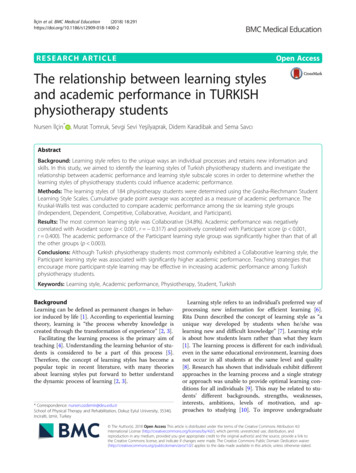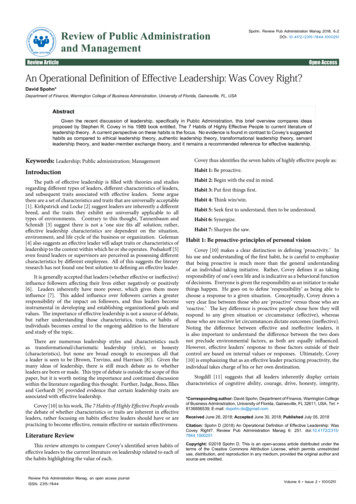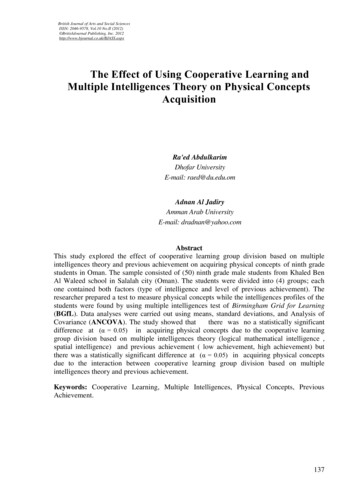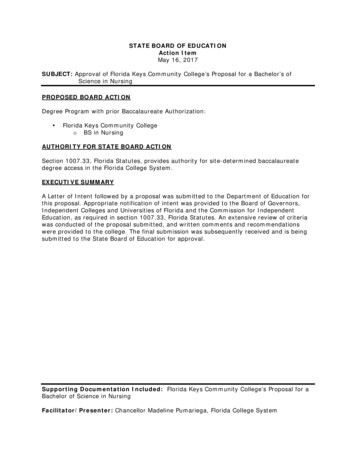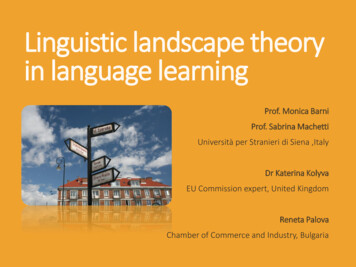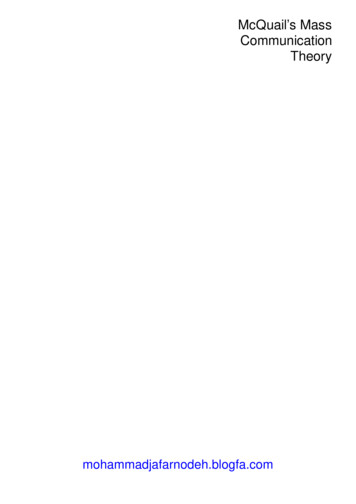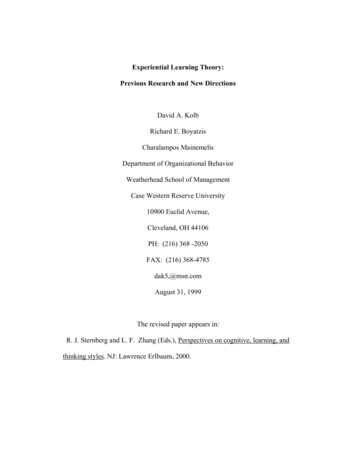
Transcription
Experiential Learning Theory:Previous Research and New DirectionsDavid A. KolbRichard E. BoyatzisCharalampos MainemelisDepartment of Organizational BehaviorWeatherhead School of ManagementCase Western Reserve University10900 Euclid Avenue,Cleveland, OH 44106PH: (216) 368 -2050FAX: (216) 368-4785dak5,@msn.comAugust 31, 1999The revised paper appears in:R. J. Sternberg and L. F. Zhang (Eds.), Perspectives on cognitive, learning, andthinking styles. NJ: Lawrence Erlbaum, 2000.
2Experiential Learning Theory: Previous Research and New DirectionsExperiential Learning Theory (ELT) provides a holistic model of thelearning process and a multilinear model of adult development, both of which areconsistent with what we know about how people learn, grow, and develop. Thetheory is called “Experiential Learning” to emphasize the central role thatexperience plays in the learning process, an emphasis that distinguishes ELT fromother learning theories. The term “experiential” is used therefore to differentiateELT both from cognitive learning theories, which tend to emphasize cognitionover affect, and behavioral learning theories that deny any role for subjectiveexperience in the learning process.Another reason the theory is called “experiential” is its intellectual originsin the experiential works of Dewey, Lewin, and Piaget. Taken together, Dewey’sphilosophical pragmatism, Lewin’s social psychology, and Piaget’s cognitivedevelopmental genetic epistemology form a unique perspective on learning anddevelopment. (Kolb, 1984).The Experiential Learning Model and Learning StylesExperiential learning theory defines learning as "the process wherebyknowledge is created through the transformation of experience. Knowledgeresults from the combination of grasping and transforming experience"(Kolb1984, p. 41). The ELT model portrays two dialectically related modes of grasping
3experience -- Concrete Experience (CE) and Abstract Conceptualization (AC) -and two dialectically related modes of transforming experience -- ReflectiveObservation (RO) and Active Experimentation (AE). According to the four-stagelearning cycle depicted in Figure 1, immediate or concrete experiences are thebasis for observations and reflections. These reflections are assimilated anddistilled into abstract concepts from which new implications for action can bedrawn. These implications can be actively tested and serve as guides in creatingnew experiences.------------------------------Insert Figure 1 about here------------------------------A closer examination of the ELT learning model suggests that learningrequires abilities that are polar opposites, and that the learner must continuallychoose which set of learning abilities he or she will use in a specific learningsituation. In grasping experience some of us perceive new information throughexperiencing the concrete, tangible, felt qualities of the world, relying on oursenses and immersing ourselves in concrete reality. Others tend to perceive, grasp,or take hold of new information through symbolic representation or abstractconceptualization – thinking about, analyzing, or systematically planning, ratherthan using sensation as a guide. Similarly, in transforming or processingexperience some of us tend to carefully watch others who are involved in the
4experience and reflect on what happens, while others choose to jump right in andstart doing things. The watchers favor reflective observation, while the doersfavor active experimentation.Each dimension of the learning process presents us with a choice. Since itis virtually impossible, for example, to simultaneously drive a car (ConcreteExperience) and analyze a driver’s manual about the car’s functioning (AbstractConceptualization), we resolve the conflict by choosing. Because of ourhereditary equipment, our particular past life experiences, and the demands of ourpresent environment, we develop a preferred way of choosing. We resolve theconflict between concrete or abstract and between active or reflective in somepatterned, characteristic ways. We call these patterned ways “learning styles.”The Learning Style Inventory and the Four Basic Learning StylesIn 1971 David Kolb developed the Learning Style Inventory (LSI) toassess individual learning styles. While individuals tested on the LSI show manydifferent patterns of scores, research on the instrument has identified fourstatistically prevalent learning styles -- Diverging, Assimilating, Converging, andAccommodating (Figure 1). The following summary of the four basic learningstyles is based on both research and clinical observation of these patterns of LSIscores (Kolb, 1984, 1999a, 1999b).
5Diverging. The Diverging style’s dominant learning abilities are ConcreteExperience (CE) and Reflective Observation (RO). People with this learningstyle are best at viewing concrete situations from many different points of view.It is labeled “Diverging” because a person with it performs better in situations thatcall for generation of ideas, such as a “brainstorming” session. People with aDiverging learning style have broad cultural interests and like to gatherinformation. Research shows that they are interested in people, tend to beimaginative and emotional, have broad cultural interests, and tend to specialize inthe arts. In formal learning situations, people with the Diverging style prefer towork in groups, listening with an open mind and receiving personalized feedback.Assimilating. The Assimilating style’s dominant learning abilities areAbstract Conceptualization (AC) and Reflective Observation (RO). People withthis learning style are best at understanding a wide range of information andputting into concise, logical form. Individuals with an Assimilating style are lessfocused on people and more interested in ideas and abstract concepts. Generally,people with this style find it more important that a theory have logical soundnessthan practical value. The Assimilating learning style is important foreffectiveness in information and science careers. In formal learning situations,people with this style prefer readings, lectures, exploring analytical models, andhaving time to think things through.
6Converging. The Converging style’s dominant learning abilities areAbstract Conceptualization (AC) and Active Experimentation (AE). People withthis learning style are best at finding practical uses for ideas and theories. Theyhave the ability to solve problems and make decisions based on finding solutionsto questions or problems. Individuals with a Converging learning style prefer todeal with technical tasks and problems rather than with social issues andinterpersonal issues. These learning skills are important for effectiveness inspecialist and technology careers. In formal learning situations, people with thisstyle prefer to experiment with new ideas, simulations, laboratory assignments,and practical applications.Accommodating. The Accommodating style’s dominant learning abilitiesare Concrete Experience (CE) and Active Experimentation (AE). People with thislearning style have the ability to learn from primarily “hand-on” experience.They enjoy carrying out plans and involving themselves in new and challengingexperiences. Their tendency may be to act on “gut” feelings rather than on logicalanalysis. In solving problems, individuals with an Accommodating learning stylerely more heavily on people for information than on their own technical analysis.This learning style is important for effectiveness in action-oriented careers such asmarketing or sales. In formal learning situations, people with theAccommodating learning style prefer to work with others to get assignments
7done, to set goals, to do field work, and to test out different approaches tocompleting a project.Factors that Shape and Influence Learning StylesThe above patterns of behavior associated with the four basic learningstyles are shown consistently at various levels of behavior. During the last threedecades researchers have examined the characteristics of learning styles at fiveparticular levels of behavior: Personality types, early educational specialization,professional career, current job role, and adaptive competencies. We summarizebriefly these research findings in Table 1 and discuss them below.-------------------------------Insert Table 1 about here-------------------------------Personality Types. ELT follows Carl Jung in recognizing that learningstyles result from individuals’ preferred ways for adapting in the world. Jung’sExtraversion/Introversion dialectical dimension as measured by the Myers-BriggsType Indicator (MBTI) correlates with the Active/Reflective dialectic of ELT asmeasured by the LSI; and the MBTI Feeling/Thinking dimension correlates withthe LSI Concrete Experience/ Abstract Conceptualization dimension. The MBTISensing type is associated with the LSI Accommodating learning style and theMBTI Intuitive type with the LSI Assimilating style. MBTI Feeling types
8correspond to LSI Diverging learning styles and Thinking types to Convergingstyles.The above discussion implies that the Accommodating learning style is theExtraverted Sensing type, and the Converging style the Extraverted Thinkingtype. The Assimilating learning style corresponds to the Introverted Intuitivepersonality type and the Diverging style to the Introverted Feeling type. Myers(1962) descriptions of these MBTI types are very similar to the corresponding LSIlearning styles as described by ELT (see also Kolb, 1984, pp: 83-85).Educational Specialization. Early educational experiences shape people’sindividual learning styles by instilling positive attitudes toward specific sets oflearning skills and by teaching students how to learn. Although elementaryeducation is generalized, there is an increasing process of specialization thatbegins at high school and becomes sharper during the college years. Thisspecialization in the realms of social knowledge influences individuals’orientations toward learning, resulting to particular relations between learningstyles and early training in an educational specialty or discipline.People with undergraduate majors in the Arts, History, Political science,English, and Psychology tend to have Diverging learning styles, while thosemajoring in more abstract and applied areas like Physical Sciences andEngineering have Converging learning styles. Individuals with Accommodating
9styles have educational backgrounds in Business and Management, and those withAssimilating styles in Economics, Mathematics, Sociology, and Chemistry.Professional Career Choice. A third set of factors that shape learningstyles stems from professional careers. One’s professional career choice not onlyexposes one to a specialized learning environment, but it also involves acommitment to a generic professional problem, such as social service, thatrequires a specialized adaptive orientation. In addition, one becomes a member ofa reference group of peers who share a professional mentality, and a common setof values and beliefs about how one should behave professionally. Thisprofessional orientation shapes learning style through habits acquired inprofessional training and through the more immediate normative pressuresinvolved in being a competent professional.Research over the years has shown that social service (i.e., psychology,nursing, social work, public policy) and arts and communications professions(i.e., theater, literature, design, journalism, media) comprise people who areheavily or primarily Diverging in their learning style. Professions in the sciences(i.e., biology, mathematics, physical sciences) and information or research (i.e.,educational research, sociology, law, theology) have people with an Assimilatinglearning style. The Converging learning styles tends to be dominant amongprofessionals in the fields of technology (i.e., engineering, computer sciences,medical technology), economics, and environment science (i.e., farming,
10forestry). Finally, the Accommodating learning style characterizes people withcareers in organizations (i.e., management, public finance, educationaladministration) and business (i.e., marketing, government, human resources).Current Job Role. The fourth level of factors influencing learning style isthe person’s current job role. The task demands and pressures of a job shape aperson’s adaptive orientation. Executive jobs, such as general management, thatrequire a strong orientation to task accomplishment and decision making inuncertain emergent circumstances require an Accommodating learning style.Personal jobs, such as counseling and personnel administration, that require theestablishment of personal relationships and effective communication with otherpeople demand a Diverging learning style. Information jobs, such as planningand research, that require data gathering and analysis, as well as conceptualmodeling, have an Assimilating learning style requirement. Technical jobs, suchas bench engineering and production that require technical and problem-solvingskills require a convergent learning orientation.Adaptive competencies. The fifth and most immediate level of forces thatshapes learning style is the specific task or problem the person is currentlyworking on. Each task we face requires a corresponding set of skills for effectiveperformance. The effective matching of task demands and personal skills resultsin an adaptive competence. The Accommodative learning style encompasses a setof competencies that can best be termed Acting skills: Leadership, Initiative, and
11Action. The Diverging learning style is associated with Valuing skills:Relationship, Helping others, and Sense-making. The Assimilating learning styleis related to Thinking skills: Information-gathering, Information-analysis, andTheory building. Finally, the Converging learning style is associated withDecision skills like Quantitative Analysis, Use of Technology, and Goal-settingKolb, 1984).An Overview of Research on ELT and the LSI: 1971-1999What has been the impact of ELT and the LSI on scholarly research?Since ELT is a holistic theory of learning that identifies learning style differencesamong different academic specialties, it is not surprising to see that ELT/LSIresearch is highly interdisciplinary, addressing learning and educational issues inseveral fields. Since the first publications in 1971 (Kolb, 1971; Kolb, Rubin &McIntyre, 1971) there have been many studies of the ELT and LSI. The mostrecent update of the Bibliography of Research on Experiential Learning Theoryand The Learning Style Inventory (Kolb & Kolb, 1999) includes 990 entries.Table 2 shows the distribution of these studies by field and publicationperiod. The field classification categories are: Education (including k-12, highereducation, and adult learning), Management, Computer/Information Science,Psychology, Medicine, Nursing, Accounting, and Law. Studies were alsoclassified as early (1971-1984) or recent (1985-1999). In addition to being the
12mid-point of the 28 1/2 year history of the work, the division makes sense in thatthe most comprehensive statement of ELT, Experiential Learning, was publishedin 1984, and the original LSI was first revised in 1985.------------------------------Insert Table 2 about here------------------------------Table 2 also shows the distribution of the 990 studies according to thepublication type. More than 50% of the studies were published in journals andanother approximately 20% were doctoral dissertations. 10% of the studies wereeither books or book chapters, and the remaining 150 studies were conferencepresentations, technical manuals, working papers, and master theses. Numbersshould be considered approximate since a few recent citations have yet to beverified by abstract or full text. Also, classification by field is not easy becausemany studies are interdisciplinary. However, the Bibliography does probablygive a fair representation of the scope, topics and trends in ELT/LSI research.The following is a brief overview of research activity in the various fields.EducationThe education category includes the largest number of ELT/LSI studies.The bulk of studies in education are in higher education (excluding professionaleducation in the specific fields identified below). K-12 education accounts for a
13relatively small number, as does adult learning alone. However, in many casesadult learning is integrated with higher education. A number of studies in theeducation category have been done in other cultures--UK, Canada, Australia,Finland, Israel, Thailand, China, Melanesia, Spain, Malta, and American Indian.Many of the studies in higher education use ELT and the LSI as aframework for educational innovation. These include research on the matching oflearning style with instructional method and teaching style and curriculum andprogram design using ELT (e.g., Claxton & Murrell, 1987). A number ofpublications assess the learning style of various student, faculty and other groups.Other work includes theoretical contributions to ELT, ELT constructvalidation, LSI psychometrics and comparison of different learning styleassessment tools. In adult learning there are a number of publications on ELT andadult development, moral development, and career development. The work ofSheckley and colleagues on adult learning at the University of Connecticut isnoteworthy here (e.g., Allen, Sheckley, & Keeton 1992; Travers, 1998). K-12education research has been primarily focused on the use of ELT as a frameworkfor curriculum design, particularly in language and science. (e.g., McCarthy,1996; Hainer, 1992)
14ManagementELT/LSI research was first published in management and there hascontinued to be substantial interest in the topic in the management literature.Studies can be roughly grouped into four categories--management andorganizational processes, innovation in management education, theoreticalcontributions to ELT including critique, and psychometric studies of the LSI.Cross-cultural ELT/LSI research has been done in Poland, New Zealand,Australia, Canada, UK, and Singapore. In the management/organization area,organizational learning is a hot topic. Dixon’s (1999) new book TheOrganizational Learning Cycle is an excellent example.Another group of studies has examined the relationship between learningstyle and management style, decision-making, and problem solving. Other workhas measured work related learning environments and investigated the effect of amatch between learning style and learning environment on job satisfaction andperformance. ELT has been used as a framework for innovation in managementeducation including research on matching learning styles and learningenvironments, program design and experiential learning in computerized businessgames (e.g., Boyatzis, Cowen, & Kolb, 1995; Lengnick-Hall & Sanders, 1997).Other education work has been on training design, managementdevelopment and career development. Another area of research has been on thedevelopment and critique of ELT. Most psychometric studies of the LSI in the
15early period were published in management, while recent psychometric studieshave been published in psychology journals. Hunsaker reviewed the early studiesin management and concluded, "The LSI does not demonstrate sufficientreliability to grant it the predictive reliability that such a measurement instrumentrequires. The underlying model, however, appears to receive enough support tomerit further use and development." (1981, p. 151)Computer and Information ScienceThe LSI has been used widely in computer and information scienceparticularly to study end-user software use and end-user training (e.g., Bostrom,Olfman, & Sein, 1990; Davis & Bostrom, 1993). Of particular interest for thisbook on individual differences in cognitive and learning styles is the debate aboutwhether these differences are sufficiently robust to be taken in account in thedesign of end-user software and end user computer training. Other studies haveexamined the relationship between learning style and problem solving anddecision making, on line search behavior, and performance in computer trainingand computer assisted instruction.PsychologyStudies in psychology have shown a large increase over time, with 77% ofthe studies in the recent period. Many of these recent studies were on LSI
16psychometrics. The first version of the LSI was released in 1976 and receivedwide support for its strong face validity and independence of the two ELTdimensions of the learning process (Marshall & Meritt, 1985; Katz, 1986).Although early critique of the instrument focused on the internal consistency ofscales and test-retest reliability, a study by Ferrell (1983) showed that the LSIversion 1 was the most psychometrically sound among four learning instrumentsof that time. In 1985 version 2 of the LSI was released and improved the internalconsistency of the scales (Veres, Sims, & Shake, 1987; Sims, Veres, Watson, &Buckner, 1986). Critiques of this version focused their attention on the test-retestreliability of the instrument, but a study by Veres, Sims, and Locklear (1991)showed that randomizing the order of the LSI version 2 items results in dramaticimprovement of test-retest reliability. This finding led to an experimental researchand finally to the latest LSI revision, LSI Version 3 (Kolb 1999a). The LSIversion 3 has significantly improved psychometric properties, especially testretest reliability (see Kolb, 1999b).Other research includes factor analytic studies of the LSI, constructvalidation studies of ELT using the LSI, and comparison of the LSI with otherlearning style and cognitive style measures. Another line of work uses ELT as amodel for personal growth and development, including examination ofcounselor/client learning style match and its impact on counseling outcomes.
17Notable here is the work of Hunt and his colleagues at the Ontario Institute forStudies in Education (Hunt, 1992,1987).MedicineThe majority of studies in medicine focus on learning style analysis inmany medical education specialties--residency training, anesthesia education,family medicine, surgical training, and continuing medical education. Ofsignificance here is the program of research by Baker and associates (e.g., Baker,Cooke, Conroy, Bromley, Hollon, & Alpert, 1988; Baker, Reines, & Wallace,1985). Also Curry (1999) has done a number of studies comparing differentmeasures of learning styles. Other research has examined clinical supervision andpatient/physician relationships, learning style and student performance onexaminations, and the relationship between learning style and medical specialtycareer choice.NursingELT/LSI research has also increased dramatically with 81% of the nursingstudies in the recent period. In 1990 Laschinger reviewed the experientiallearning research in nursing and concluded, "Kolb's theory of experientiallearning has been tested extensively in the nursing population. Researchers haveinvestigated relationships between learning style and learning preferences,
18decision-making skills, educational preparation, nursing roles, nursing specialty,factors influencing career choices and diagnostic abilities. As would be expectedin a human service profession, nursing learning environments have been found tohave a predominantly concrete learning press, matching the predominatingconcrete styles of nurses Kolb's cycle of learning which requires the use of avariety of learning modalities appears to be a valid and useful model forinstructional design in nursing education" (p. 991).AccountingThere has been considerable interest in ELT/LSI research in accountingeducation, where there have been two streams of research activity. One is thecomparative assessment of learning style preferences of accounting majors andpractitioners, including changes in learning style over the stages of career inaccounting and the changing learning style demands of the accounting professionprimarily due to the introduction of computers. Other research has been focusedon using ELT to design instruction in accounting and studying relationshipsbetween learning style and performance in accounting courses.In 1991 Stout and Ruble reviewed ELT/LSI research in accountingeducation. Reviewing the literature on predicting the learning styles ofaccounting students they found mixed results and concluded that low predictiveand classification validity for the LSI was a result of weak psychometric qualities
19of the original LSI and response set problems in the LSI 1985. They tentativelyrecommended the use of the randomized version proposed by Veres, Sims, andLocklear (1991). They write, "researchers who wish to use the LSI for predictiveand classification purposes should consider using a scrambled version of theinstrument", and note, " it is important to keep in mind that assessing thevalidity of the underlying theoretical model (ELT) is separate from assessing thevalidity of the measuring instrument (LSI). Thus, for example, the theory may bevalid even though the instrument has psychometric limitations. In such a case,sensitivity to differences in learning styles in instructional design may bewarranted, even though assessment of an individual's learning style isproblematic" (p. 50).LawWe are now seeing the beginning of significant research programs in legaleducation, for example the program developed by Reese (1998) using learningstyle interventions to improve student learning at the University of Denver LawSchool.Evaluation of ELT and the LSIThere have been two recent comprehensive reviews of the ELT/LSIliterature, one qualitative and one quantitative. In 1991 Hickox extensively
20reviewed the theoretical origins of ELT and qualitatively analyzed 81 studies inaccounting and business education, helping professions, medical professions,post-secondary education and teacher education. She concluded that overall61.7% of the studies supported ELT, 16.1% showed mixed support, and 22.2%did not support ELT.In 1994 Iliff conducted a meta-analysis of 101 quantitative studies culledfrom 275 dissertations and 624 articles that were qualitative, theoretical, andquantitative studies of ELT and the LSI. Using Hickox's evaluation format hefound that 49 studies showed strong support for the LSI, 40 showed mixedsupport and 12 studies showed no support. About half of the 101 studies reportedsufficient data on the LSI scales to compute effect sizes via meta-analysis. Moststudies reported correlations he classified as low ( .5) and effect sizes fell in theweak (.2) to medium (.5) range for the LSI scales. In conclusion Iliff suggeststhat the magnitude of these statistics is not sufficient to meet standards ofpredictive validity.Most of the debate and critique in the ELT/LSI literature has centered onthe psychometric properties of the LSI. Results from this research have been ofgreat value in revising the LSI in 1985 and again in 1999. Other critique,particularly in professional education, has questioned the predictive validity of theLSI. Iliff correctly notes that the LSI was not intended to be a predictivepsychological test like IQ, GRE or GMAT. The LSI was originally developed as
21a self-assessment exercise and later used as a means of construct validation forELT. Tests designed for predictive validity typically begin with a criterion likeacademic achievement and work backward in an a-theoretical way to identifyitems or tests with high criterion correlations. Even so, even the mostsophisticated of these tests rarely rises above a .5 correlation with the criterion.For example, while Graduate Record Examination Subject Test scores are betterpredictors of first-year graduate school grades than either the General Test scoreor undergraduate GPA, the combination of these three measures only producesmultiple correlations with grades ranging from .4 to .6 in various fields (Anastasi& Urbina, 1997). While researchers in the professions are understandablysearching for measures with high predictive validity to aid in decision-making, amore realistic approach than relying on any single measure is to rely on predictionfrom new multi-trait multi-method techniques such as structural equationmodeling (e.g. White & Manolis, 1997; Coover 1993; Travers, 1998).Construct validation is not focused on an outcome criterion, but on thetheory or construct the test measures. Here the emphasis is on the pattern ofconvergent and discriminant theoretical predictions made by the theory. Failureto confirm predictions calls into question the test and the theory. "However, evenif each of the correlations proved to be quite low, their cumulative effect would beto support the validity of the test and the underlying theory" (Selltiz, Jahoda,Deutsch, & Cook, 1960, p. 160). Judged by the standards of construct validity
22ELT has been widely accepted as a useful framework for learning centerededucational innovation, including instructional design, curriculum development,and life-long learning. Field and job classification studies viewed as a whole alsoshow a pattern of results consistent with the ELT structure of knowledge theorydescribed in Table 1.Recent critique has been more focused on the theory than the instrumentexamining the intellectual origins and underlying assumptions of ELT from whatmight be called a post-modern perspective where the theory is seen asindividualistic, cognitivist, and technological (e.g. Vince, 1998; Holman, 1997;Hopkins, 1993).New Directions in ELT: From Specialized to Balanced Learning StylesTo date the vast of majority of ELT-related research has examinedconditions of extreme learning specialization; a new direction for ELT is theempirical testing of its theoretical propositions with regard to integrated learning.Integrated learning is conceptualized as an idealized learning cycle or spiralwhere the learner "touches all the bases"--experienci
The Experiential Learning Model and Learning Styles Experiential learning theory defines learning as "the process whereby knowledge is created through the transformation of experience. Knowledge results from the combination of grasping and transforming experience"(Kolb 1984, p. 41). The ELT m
